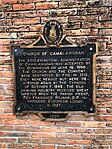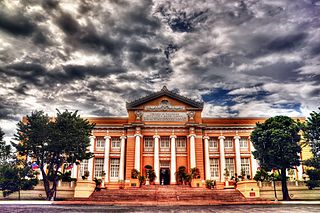
Pangasinan, officially the Province of Pangasinan, is a coastal province in the Philippines located in the Ilocos Region of Luzon. Its capital is Lingayen. Pangasinan is in the western area of Luzon along Lingayen Gulf and the South China Sea. It has a total land area of 5,451.01 square kilometres (2,104.65 sq mi). According to the 2020 census, it has a population of 3,163,190. The official number of registered voters in Pangasinan is 1,651,814. The western portion of the province is part of the homeland of the Sambal people, while the central and eastern portions are the homeland of the Pangasinan people. Due to ethnic migration, the Ilocano people settled in the province.

Aguilar, officially the Municipality of Aguilar, is a 3rd class municipality in the province of Pangasinan, Philippines. According to the 2020 census, it has a population of 45,100 people.

Pozorrubio, officially the Municipality of Pozorrubio, is a 1st class municipality in the province of Pangasinan, Philippines. According to the 2020 census, it has a population of 74,729 people.

Camalaniugan, officially the Municipality of Camalaniugan, is a 4th class municipality in the province of Cagayan, Philippines. According to the 2020 census, it has a population of 25,236 people.
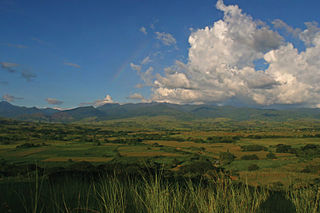
Cabagan, officially the Municipality of Cabagan, is a 1st class municipality in the province of Isabela, Philippines. According to the 2020 census, it has a population of 53,897 people.

Tumauini, officially the Municipality of Tumauini, is a 1st class municipality in the province of Isabela, Philippines. According to the 2020 census, it has a population of 70,743 people.

The Captaincy General of the Philippines was an administrative district of the Spanish Empire in Southeast Asia governed by a governor-general as a dependency of the Viceroyalty of New Spain based in Mexico City until Mexican independence when it was transferred directly to Madrid.

During the Spanish colonial period in the Philippines (1565–1898), there were several revolts against the Spanish colonial government by indigenous Moro, Lumad, Indios, Chinese (Sangleys), and Insulares, often with the goal of re-establishing the rights and powers that had traditionally belonged to Lumad communities, Maginoo rajah, and Moro datus. Some revolts stemmed from land problems and this was largely the cause of the insurrections that transpired in the agricultural provinces of Batangas, Bulacan, Cavite, and Laguna. Natives also rebelled over unjust taxation and forced labor.

The Archdiocese of Nueva Segovia is an archdiocese of the Catholic Church in the Philippines. It covers the province of Ilocos Sur, on the island of Luzon. The see of the archdiocese is the city of Vigan.

The Our Lady of Remedies Parish, also known as Malate Church, is a Roman Catholic parish church in the district of Malate in the city of Manila, Philippines. This Mexican Baroque-style church is overlooking Plaza Rajah Sulayman and, ultimately, Manila Bay. The church is dedicated to Nuestra Señora de los Remedios, the patroness of childbirth. A revered statue of the Virgin Mary in her role as Our Lady of Remedies was brought from Spain in 1624 and stands at the altar.
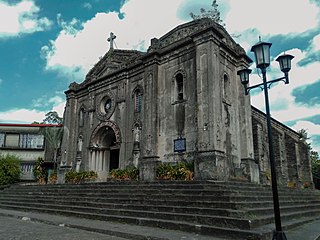
The Nuestra Señora de Gracia Church, also known as Guadalupe Church, is a Baroque Roman Catholic church in Makati City, Philippines. The parish church and its adjacent monastery are currently administered by the Augustinian friars of the Province of Santo Niño de Cebu. The territory of the parish covers San Carlos Seminary, the major seminary of the Archdiocese of Manila and Our Lady of Guadalupe Minor Seminary. The church also has an adjacent seminary, the Monasterio de Guadalupe, which admits young professionals for priestly and religious vocation. The current parish priest is Danilo M. Carido.

The Saints Peter and Paul Parish Church, commonly known as Calasiao Church, is a baroque church located in Poblacion West, Calasiao, Pangasinan, Philippines. It belongs to the Vicariate of Sts. Peter and Paul under the Ecclesiastical Province of the Roman Catholic Archdiocese of Lingayen-Dagupan. The 57,840 Catholics is under the pastoral care of Rev. Fidelis B. Layog, assisted by Rev. Isidro Palinar, Jr. and Rev. Raymund Manaois.

La Purisima Concepcion de la Virgen Maria Parish Church, commonly known as Baclayon Church, is a Roman Catholic church in the municipality of Baclayon, Bohol, Philippines within the jurisdiction of the Diocese of Tagbilaran. Baclayon was founded by the Jesuit priest Juan de Torres and Gabriel Sánchez in 1596, and became the oldest Christian settlement in Bohol. It was elevated as a parish in 1717 and the present coral stone church was completed in 1727. The Augustinian Recollects succeeded the Jesuits in 1768 and heavily renovated the church since then.

The San Agustin Parish Church, also known as the Lubao Church, is a 17th-century Neo-classic, Spanish stone and brick church located at Brgy. San Nicolas 1st, Lubao, Pampanga, Philippines. In 1952, a historical marker bearing a brief history of the structure was installed on the facade of the church by the Historical Committee of the Philippines, precursor of the National Historical Commission of the Philippines. In 2013, the church has been declared by the National Museum of the Philippines as an Important Cultural Property.

The Saint Peter Metropolitan Cathedral, also known as the Tuguegarao Cathedral, is an 18th-century Baroque Roman Catholic church located along Rizal Street, Barangay Centro 10, Tuguegarao, Cagayan, Philippines. The church, originally built by Dominican friars, is the seat of the Roman Catholic Archdiocese of Tuguegarao and is considered one of the largest churches in the Cagayan Valley. A historical marker bearing a brief history of the church was installed in 1982 by the National Historical Institute, precursor of the National Historical Commission of the Philippines.
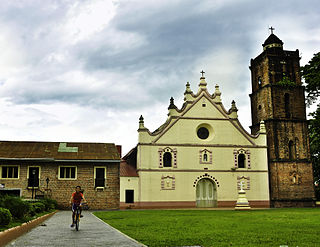
The Saint Vincent Ferrer Parish Church, commonly referred to as Dupax Church or Dupax del Sur Church, is an 18th-century Baroque Roman Catholic church located at Brgy. Dopaj, Dupax del Sur, Nueva Vizcaya, Philippines. The parish church, under the advocation of Saint Vincent Ferrer, is under the jurisdiction of the Diocese of Bayombong. The church complex has been declared a National Cultural Treasure by the National Museum of the Philippines in July 2001.

The San Raimundo de Peñafort Parish Church, commonly referred to as the Malaueg Church or Rizal Church, is an early 17th-century Baroque Roman Catholic church located at Brgy. Poblacion, Rizal, Cagayan, Philippines. The parish church, with Saint Raymond of Peñafort as its titular patron, is under the jurisdiction of the Roman Catholic Archdiocese of Tuguegarao. The church structure has been declared a National Cultural Treasure by the National Museum of the Philippines in 2001. A marker, bearing a brief history of the church, was installed on the church's facade by the National Historical Commission of the Philippines.

The Santa Ana Parish Church, commonly known as the Piddig Church, is a Roman Catholic parish church in Piddig, Ilocos Norte, Philippines. Originally a visita of Dingras, it was raised into an independent parish in 1770. In September 2014, the 200-year-old church of Saint Anne Parish in Piddig, Ilocos Norte was closed for public worship after it was deemed unsafe.

The Minor Basilica of Saint Dominic, also known as the Saint Dominic Parish Church, is a Roman Catholic minor basilica located in San Carlos, Pangasinan in the Philippines. The church, made out of bricks or ladrillo, used to be the largest Catholic church in the Philippines during the late 18th century, The church was finished in 1773, under the administration of Father Cristobal Ausina. However, it was destroyed by three earthquakes in 1789, 1796, and 1799.
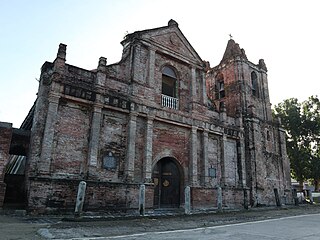
Saint Dominic de Guzman Parish Church, commonly known as Lal-lo Church, is a Roman Catholic church located in Lal-lo, Cagayan, Philippines. It was built by the Dominican priests in 1596. The facade, with neo-Renaissance style, may have been applied as part of the renovation of the church after a storm in 1845. The National Historical Commission of the Philippines (NHCP) declared it a national landmark and installed a historical marker on the church's facade in 1939.



